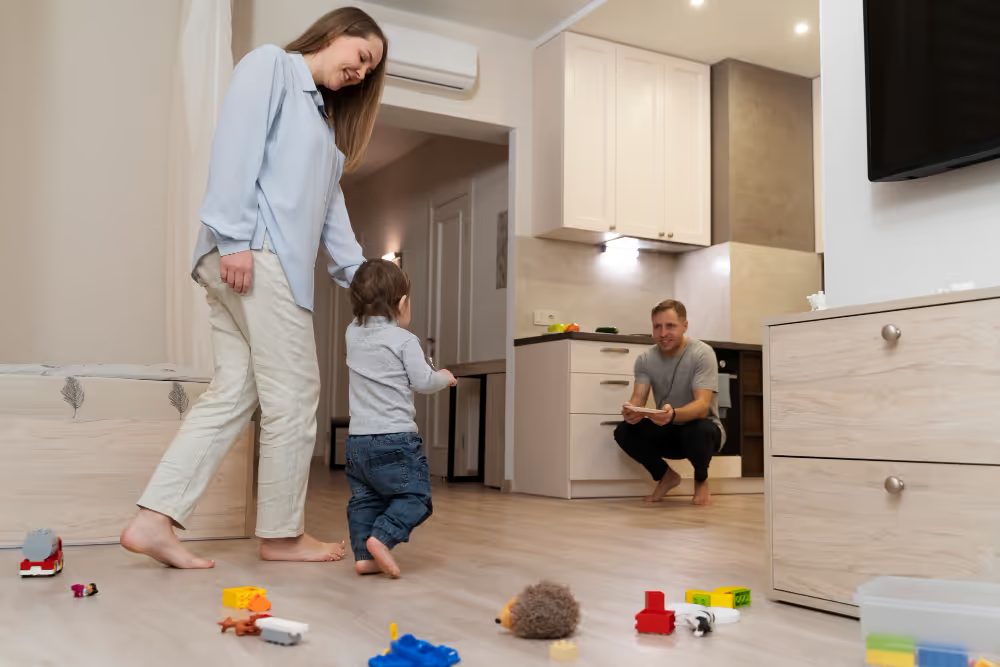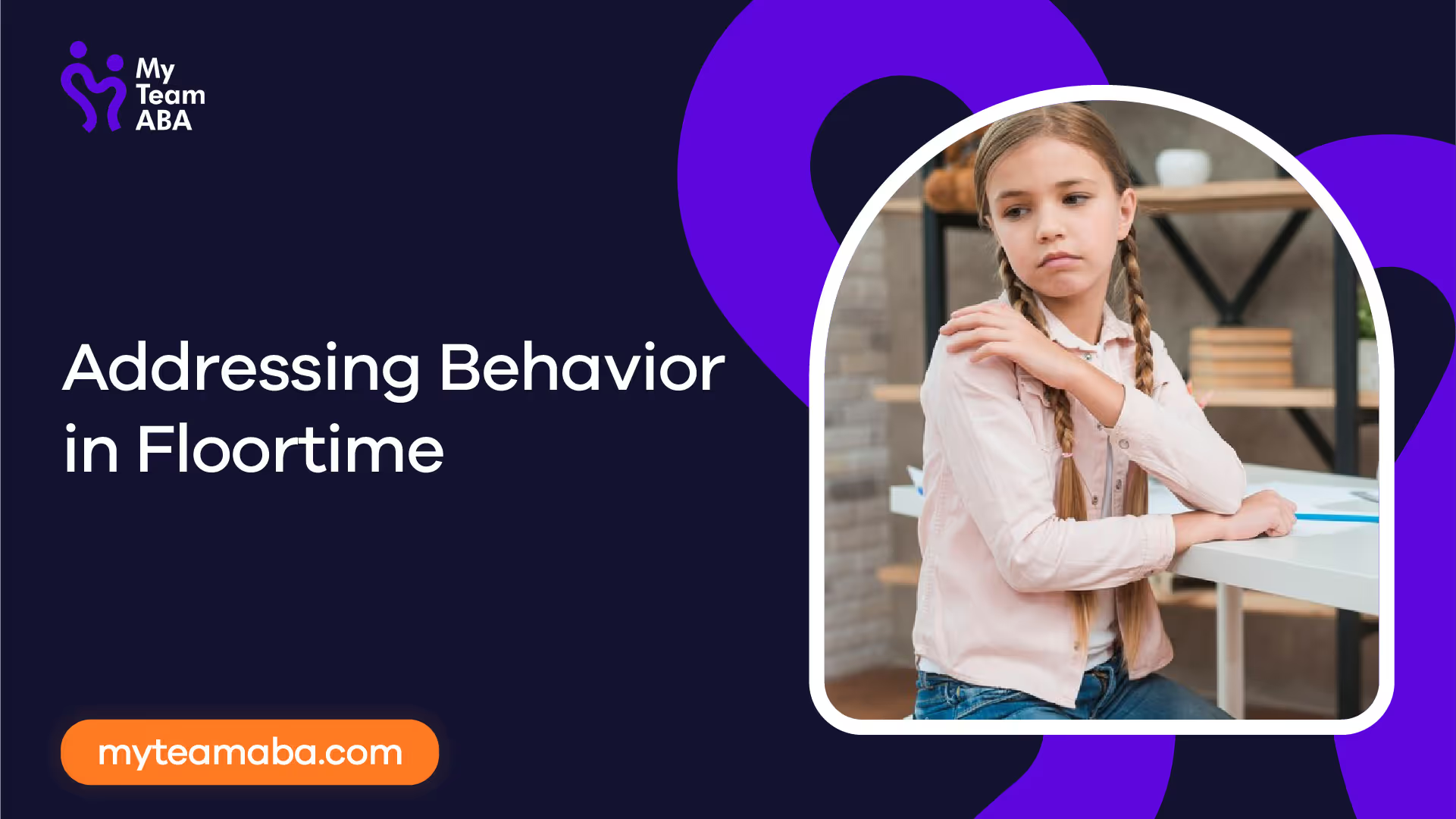Addressing Behavior in Floortime
March 3, 2025
Overcome behavior hurdles in Floortime sessions with effective strategies and techniques. Addressing behavior in Floortime made easy!

Understanding Behavior Challenges
When engaging in Floortime, it is essential to have a solid understanding of behavior challenges that may arise during sessions. By recognizing the reasons behind certain behaviors and the impact of overstimulation, caregivers and practitioners can effectively address and support children in their developmental journey.
Reasons Behind Behavior
Children with behavioral challenges may engage in inappropriate behavior for various reasons. It is important to approach these behaviors with empathy and understanding rather than punishment or reasoning. In a developmental approach like Floortime, it is recognized that children engage in behaviors for a reason. Some possible reasons behind behavior challenges include:
- Seeking attention: Children may engage in inappropriate behavior to gain attention from their parents or caregivers. They may be intrigued by the emotional reactions they elicit.
- Testing cause and effect: Children often experiment with cause and effect by engaging in inappropriate behavior and observing the emotional responses of their parents or caregivers. This becomes a game for them and piques their curiosity.
- Expressing frustration or discomfort: Behavior challenges can also stem from a child's difficulty in expressing their frustrations or discomfort. Inappropriate behavior may be an attempt to communicate their needs or emotions.
By understanding the underlying reasons behind behavior challenges, parents and practitioners can approach these situations with patience, empathy, and effective strategies.
Impact of Overstimulation
Children with behavior challenges may struggle to organize themselves when there is an excessive amount of stimulation, leading to overstimulation of their nervous system. This can result in increased stress levels and difficulty regulating emotions. Overstimulation can manifest in various ways, such as increased hyperactivity, meltdowns, or engaging in repetitive or self-stimulating behaviors.
To support children in Floortime sessions, it is important to create clear routines and provide a structured environment. Predictability and consistency help children understand expectations, reducing anxiety and providing a sense of security. By managing the environment and gradually exposing children to new experiences, parents and practitioners can help them develop emotional regulation skills and cope with overstimulation more effectively.
Understanding behavior challenges and the impact of overstimulation sets the foundation for implementing effective strategies in Floortime sessions. By acknowledging the reasons behind behaviors and creating an environment that supports emotional regulation, caregivers and practitioners can foster development and overcome hurdles in the Floortime journey.

Floortime Approach Overview
When it comes to addressing behavior challenges in children, the Floortime approach offers a unique and effective method. Developed by Dr. Stanley Greenspan, Floortime therapy, also known as DIR/Floortime (Developmental, Individual-Difference, Relationship-based model), emphasizes the importance of following a child's lead and engaging in interactive play on the child's level, typically on the floor, to build emotional connections and foster development [2].
Fundamentals of Floortime
At the core of Floortime therapy is the belief that meaningful relationships and interactions are essential for a child's development, particularly for those with autism spectrum disorder (ASD). Rather than using a directive approach, Floortime encourages caregivers to join the child in their play, allowing the child's interests to guide the interaction.
During Floortime sessions, caregivers actively participate in play activities that align with the child's preferences. This approach helps to promote engagement, develop communication skills, and enhance social interactions. By focusing on the child's interests and building emotional connections, Floortime aims to support the child's overall development.
Benefits of DIR Floortime
DIR/Floortime therapy has proven to be highly effective in supporting the development and social-emotional growth of children with ASD. By targeting the core challenges faced by individuals on the autism spectrum, Floortime helps address behavior challenges and promotes positive outcomes.
Some of the key benefits of DIR Floortime include:
- Enhanced Communication Skills: Floortime therapy techniques play a vital role in enhancing communication skills in children, including nonverbal communication, vocabulary expansion, and expressive language. Caregivers actively listen and respond to the child's communication attempts, validating their feelings and thoughts. This helps children develop more effective communication strategies and increases their confidence in expressing themselves.
- Social Interaction Development: Through interactive play, Floortime promotes the development of social skills and the ability to engage in reciprocal interactions. By joining the child's play and following their lead, caregivers create a safe and supportive environment for the child to practice social interactions, such as turn-taking, sharing, and joint attention. This helps children build important social-emotional connections and develop meaningful relationships.
- Emotional Regulation: Floortime therapy recognizes the importance of emotional connections and emotional regulation in a child's development. By engaging in play experiences that are emotionally meaningful to the child, caregivers help children identify and express their emotions. This contributes to better emotional regulation and the development of emotional resilience.
- Individualized Approach: Floortime therapy acknowledges that each child is unique and has individual strengths and challenges. By following a child's lead and focusing on their specific interests, Floortime provides a personalized approach that supports the child's developmental needs. This individualized approach allows for targeted interventions that address behavior challenges effectively [2].
By embracing the fundamentals of Floortime and harnessing the benefits of DIR/Floortime therapy, caregivers can provide a nurturing and supportive environment that helps children overcome behavior hurdles and reach their full potential.
Implementing Floortime Strategies
When implementing Floortime strategies to address behavior challenges, it's important to create clear routines and effectively address inappropriate behavior. By establishing a structured environment and responding empathetically to a child's behavior, Floortime can help promote positive interactions and emotional growth.
Creating Clear Routines
Children with behavior challenges often benefit from clear routines and expectations. By creating a consistent schedule, parents and caregivers can help children understand what to expect and provide a sense of predictability. This can be particularly helpful for children who struggle with transitions or have difficulty organizing themselves when there is too much happening.
When establishing routines, it's essential to consider the child's individual needs and preferences. By involving the child in the process and allowing them to have some control and decision-making power, they are more likely to engage and cooperate. Flexibility within the routine is also important, as it allows for adjustments to accommodate unexpected situations or changing needs.
Addressing Inappropriate Behavior
In Floortime, it is crucial to approach behavior challenges with understanding and empathy. Instead of punishing or reasoning with the child, it is important to recognize that they engage in certain behaviors for a reason. Inappropriate behavior may be a way for the child to communicate their needs, test boundaries, or seek attention.
When addressing inappropriate behavior, it's essential to remain calm and composed. Reacting with frustration or anger can inadvertently reinforce the behavior, as some children may find their parents' emotional reactions intriguing or entertaining. Instead, parents and caregivers can model appropriate behavior and guide the child towards more acceptable alternatives.
Redirecting the child's attention to a more appropriate activity or offering choices can be effective strategies. For example, if a child engages in aggressive behavior, redirecting their focus towards a sensory activity or providing them with alternative ways to express their emotions can help diffuse the situation. It is important to consistently reinforce positive behavior and provide praise and encouragement when the child demonstrates appropriate responses.
By implementing clear routines and addressing inappropriate behavior with empathy and understanding, Floortime can provide a supportive framework for children with behavior challenges. The ultimate goal is to promote emotional growth, strengthen relationships, and facilitate positive interactions between children and their caregivers.
DIRFloortime Techniques
When addressing behavior challenges in Floortime sessions, employing effective techniques is essential for promoting engagement and emotional connections with the child. Two key techniques commonly used in DIRFloortime are engaging in play and promoting emotional connections.
Engaging in Play
Engaging in play is a fundamental aspect of Floortime therapy. Through play, therapists and caregivers actively participate in the child's world, following their lead and interests. By joining the child in their play, they create opportunities for interaction and communication.
During play sessions, caregivers play an active role in expanding the child's play ideas and encouraging them to explore new possibilities. This process helps promote problem-solving skills, creativity, and cognitive development. Additionally, play sessions offer a safe environment for the child to express their emotions and thoughts, fostering emotional resilience.
To facilitate engagement in play, caregivers can:
- Observe and join in the child's ongoing play activities, following their lead.
- Expand on the child's play ideas by introducing new elements or ideas.
- Use open-ended questions to encourage the child to think critically and problem solve.
- Incorporate the child's interests into play activities, providing motivation and enjoyment.
- Provide a supportive and non-judgmental environment, allowing the child to freely express themselves.
Promoting Emotional Connections
Promoting emotional connections is a vital component of DIRFloortime. Building a strong emotional bond between the child and caregiver is crucial for fostering trust and facilitating communication. In this approach, caregivers actively listen and respond to the child's communication attempts, validating their feelings and thoughts.
To promote emotional connections during Floortime sessions, caregivers can:
- Maintain eye contact, facial expressions, and body language that reflect attentive listening.
- Respond promptly and empathetically to the child's nonverbal and verbal cues.
- Use reflective language to acknowledge and validate the child's emotions.
- Encourage the child to express their feelings through words, gestures, or play.
- Provide a calm and supportive presence, creating a sense of safety and security.
By promoting emotional connections, caregivers help children develop more effective communication strategies and increase their confidence in expressing themselves. This, in turn, contributes to the child's overall development and enhances their social-emotional skills.
By employing these DIRFloortime techniques, caregivers and therapists can address behavior challenges while fostering engagement, communication, and emotional growth in children. It is important to remember that each child is unique, and the techniques used should be tailored to their specific strengths, interests, and needs.
Greenspan Floortime Effectiveness
When considering the effectiveness of Greenspan Floortime as a therapeutic approach, it is important to examine the evidence and research supporting its use, as well as the success stories shared by individuals who have benefited from this method.
Evidence and Research
Floortime therapy, which incorporates elements of Greenspan Floortime, is an evidence-based approach used in Applied Behavior Analysis (ABA) to support the development and social-emotional growth of children with autism spectrum disorder (ASD) [2]. Although research specifically focused on Greenspan Floortime may be limited, studies have demonstrated the effectiveness of Floortime therapy in improving social communication skills, emotional regulation, and overall development in children with ASD.
The DIRFloortime model, developed by Dr. Stanley Greenspan and Dr. Serena Wieder, provides a structured framework for implementing Greenspan Floortime techniques. Certified DIRFloortime experts offer guidance on how to play and interact with children in ways that motivate them, capitalize on their natural interests, and facilitate the development of essential new social, emotional, and intellectual skills [3].
While there is ongoing research on the effectiveness of Greenspan Floortime, anecdotal evidence and the experiences of practitioners and parents suggest that this approach can have a positive impact on the social-emotional development and behavior of children with developmental challenges.
Success Stories
Numerous success stories have emerged from individuals who have undergone Greenspan Floortime therapy or similar approaches based on the DIRFloortime model. These stories highlight the transformative effects of this therapeutic method on individuals with developmental challenges.
By engaging in play, promoting emotional connections, and following the principles of Greenspan Floortime, children have shown improvements in various areas such as social interaction, emotional regulation, communication skills, and cognitive development. The practical application of Greenspan Floortime strategies has helped children lessen challenging behaviors and develop essential skills.
While each child's experience with Greenspan Floortime may vary, these success stories provide hope and inspiration for families seeking effective interventions to support their child's development and well-being.
As with any therapeutic approach, it is important to consult with qualified professionals and individualize the treatment to meet the specific needs of each child. The effectiveness of Greenspan Floortime can be enhanced when implemented with cultural considerations, early intervention strategies, and other complementary approaches such as mindfulness and attachment-based techniques.
By incorporating the principles and techniques of Greenspan Floortime, individuals with developmental challenges can unlock their potential, fostering growth and development in essential areas of social-emotional functioning and behavior.
Contrasting ABA and Floortime
When it comes to addressing behavior challenges in children, two prominent approaches often discussed are Applied Behavior Analysis (ABA) and Floortime. While both approaches aim to support children's development, they differ in their philosophies and techniques. Let's delve into a comparison of these approaches and explore the potential for a combined approach.
Approaches Comparison
- Applied Behavior Analysis (ABA): ABA is an approach centered on changing human behavior by using extrinsic motivators such as reinforcement and punishment to make the child conform to social norms. The goal is often to make the autistic child indistinguishable from their non-autistic peers. ABA values the attainment of normal behaviors and compliance with social norms, with the aim of making the child look and behave normally.
- DIR Floortime: Developmental, Individual-differences, Relationship-based Floortime (DIR Floortime) emphasizes individual differences (neurodiversity) and supports children in achieving their fullest potential without the goal of normalization but of overall improvement in development and quality of life. Floortime is significantly more focused on emotional connection and development than on behavior. It is characterized as being more child-led and focused on social and relational deficits.
While both ABA and Floortime have their merits, they differ in their underlying philosophies and approaches. ABA primarily focuses on behavior modification, utilizing structured and repetitive teaching methods to reinforce desired behaviors and discourage unwanted behaviors. On the other hand, Floortime places great importance on emotional connections, individual differences, and social interaction, allowing the child to lead the play and encouraging creativity and independence.
Combined Approach Potential
Recognizing the strengths and limitations of each approach, some professionals and parents advocate for a combined approach that incorporates elements of both ABA and Floortime. This blended approach aims to leverage the benefits of each method to create a more comprehensive and individualized intervention.
One example of a combined approach is Pivotal Response Treatment (PRT), developed by Drs. Robert and Lynn Koegel at the University of California. PRT takes a more natural approach, similar to Floortime, while employing the principles of ABA to reward desirable behaviors. This approach focuses on pivotal areas of development, such as motivation, self-initiation, and responsive communication, while also incorporating principles of ABA, such as reinforcement.
By combining elements from both ABA and Floortime, a comprehensive approach can be created that addresses behavior challenges while nurturing emotional connections and individual differences. As with any therapeutic approach, it is crucial to consider the unique needs of the child and tailor the intervention accordingly.
In conclusion, ABA and Floortime represent two distinct approaches to addressing behavior challenges in children. While ABA focuses on behavior modification, Floortime emphasizes emotional connections and individualized development. Exploring a combined approach, such as Pivotal Response Treatment, can provide a more holistic intervention that considers both behavior and emotional development. Ultimately, the choice of approach should be based on the individual needs and goals of the child, as well as the guidance of qualified professionals.
